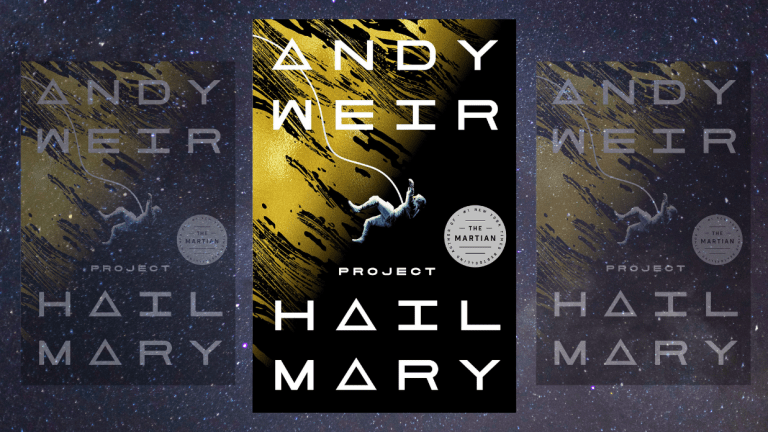Project Hail Mary Review
Andy Weir follows The Martian and Artemis with an outstanding interstellar road trip.

After the runaway success of The Martian, culminating in a big budget Hollywood blockbuster helmed by Ridley Scott and starring Matt Damon, expectations have run high for each new Andy Weir book. His sophomore effort, Artemis, was a change of pace, a science fiction thriller set inside a city on the Moon. Project Hail Mary uses a broader canvas as the backdrop for an interstellar race against time, but it still cleaves to Weir’s favorite themes: competence in the face of adversity, and a willingness to fight for survival. One key difference is that the stakes are higher in Project Hail Mary: rather than one life being at risk, Weir’s antagonist in this book threatens the survival of the entire human race, and other galactic civilizations beside our own.
Ryland Grace wakes up in a medical bay with two dead bodies, tubes sticking out of his body, and no idea of who he is, or how he got aboard what he soon finds out is a starship. As the plot unfolds, Grace begins to slowly recover his memories; not only does he discover the nature of the crisis facing humanity, but also learns that he isn’t exactly the type of man he thinks he is. It’s clear that Weir is maturing as a writer. Grace is a science teacher, rather than an astronaut. That was a conscious decision, as Weir told me during a recent interview: “Mark Watney [protagonist of The Martian] was a bad-ass, right? He was humble, he was funny, and self-effacing, and stuff like that, but he was an astronaut selected to go to Mars. He must’ve beat out 10,000 other candidates, so he’s the cream of the crop, absolutely top in his field. I wanted somebody who was more of an everyman.” Adding that he believes himself to be strong on plots but weak on characters, Weir says that he sets out to develop more nuanced protagonists which each new book.
In this, he definitely succeeds. Far from the gung-ho, super-motivated type, Grace is very much a reluctant hero, one with real vulnerabilities which help humanize him and add shades of grey. Yet the strongest character in the book is arguable Rocky, Grace’s alien counterpart. Creating a compelling literary alien can be challenging, but Weir gives us a memorable character who soon endears himself to the reader and has us rooting for “him” to succeed. The Martian required little in the way of world building; Project Hail Mary, on the other hand, gives us a well-constructed alien race, with a home world very different from ours. Weir is a self-avowed Star Trek fan, but said he wanted to do a little more with his alien species than “just add some forehead bumps, and call it a day.” There’s also no universal translator to provide quick and convenient communication between the two protagonists. Weir takes the time to devise a logical and intuitive way for Grace and Rocky to converse, then lets it slide into the background once the reader has come to accept it. It’s a neat narrative device that never gets in the way of him telling the story.
Every compelling novel needs a strong antagonist, and what’s notable about Project Hail Mary is that it comes in the form of the Astrophage, an alien life form which transmits itself from star to star like a virus, slowly snuffing each one out along the way. Part of the genius of the Astrophage is that it’s completely indifferent to the existence of those civilizations it threatens. It can’t be threatened or reasoned with. As such, the only solution is a scientific one, and as with other Andy Weir books, the true hero is not humanity – it’s science. There’s a lot of science in this book, which is by no means a bad thing, but it will require some readers to go over several passages carefully and perhaps repeatedly. I found myself going over some of the concepts several times, making sure I really understood the science lesson that Andy Weir was teaching me through the voice of Ryland Grace. Weir is a writer who always does his homework, and there’s a lot to unpack here, especially if your understanding of physics isn’t the best (as this reviewer’s isn’t). That shouldn’t scare off potential readers, however; the book never stoops to lecturing, and the exposition is kept to what’s necessary to advance the plot. Thanks to a unique structure in which the novel moves forward from two different starting points and alternates between them, the plot is constantly moving forward, and each reveal leaves the reader wanting to know what’s coming next, until culminating in a very satisfying final chapter that makes the whole journey worthwhile.
In many ways, Project Hail Mary feels like something that Clarke, Asimov, or Heinlein might have written. The message is clear: in the face of impending planetary devastation, human ingenuity backed by solid science is the only thing that can save us. A willingness to cooperate with those who are different from us is a key part of humanity’s salvation. Weir manages to work these themes into the book in a subtle enough manner that they are clear to see, but without being intrusive. The movie rights have already been sold to MGM, with Phil Lord and Christopher Miller set to direct; it’s well worth discovering the story in its original format first, before the Hollywood adaptation hits the big screen.
While there are no space battles or alien invasions, Project Hail Mary is no less a gripping journey for that. Andy Weir has turned in a smart, unpredictable novel that makes for highly recommended summer reading.
Project Hail Mary hits the shelves on Tuesday, May 3rd. Weir’s exclusive UK Virtual Book Tour event is on Wednesday 5th May. You can find out more about that here.
